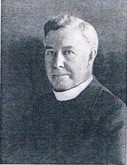Charles Herbert Ellison |
Research by Liz Bickerstaffe
|
|
Canon Charles Herbert Ellison donated a painting described as 'The Straits of Messina given to the Corporation by Canon C H Ellison, 23.12.35'. Stephen Sartin (2001) notes that 'no trace of a painting with this title is in Fylde Borough Collection'. It is also relevant that the painting was attributed to George Chambers, whose work On the Thames at Greenwich had been donated by Alderman Dawson three months previously. At present there is not sufficient information to identify it with any unattributed paintings in the Lytham St Annes Art Collection.
Sartin also wonders if this painting is Dutch Pinks Returning from the Sea, Katwyke Holland (Acc No 39). Elsewhere this painting is titled Dutch Pinks returning from the Dogger Bank, Katwyke Holland (E Hayes). Dogger Bank is a large sandbank in a shallow area of the North Sea about 100 kilometres (62 miles) off the east coast of England and has been the site of several naval actions. This picture was painted c1876-77 and it has been suggested that it could depict The Battle of Dogger Bank that took place during the War of the Grand Alliance (The Nine Years War). In June 1696, a French fleet, under the command of Jean Bart, was victorious over the ships of the Grand Alliance, a Dutch convoy under Rutger Bucking. Alternatively, it could refer to The Battle of Dogger Bank, August 1781, that took place during the Fourth Anglo-Dutch War between a British squadron under Hyde Parker and a Dutch squadron under Johan Zoutman. It is highly unlikely that a painting entitled The Straits of Messina, which is the narrow passage between the eastern tip of Sicily (Punta del Faro) and the western tip of Calabria (Punta Pezzo) in the south of Italy, would depict ships returning from England to the Netherlands. Charles Herbert Ellison MA was the son-in-law of another donor, Florence Mather.  CHARLES HERBERT ELLISON MA
(1870-1939) CHARLES HERBERT ELLISON MA
(1870-1939)
Charles was the son of the Reverend Joseph Rowland Ellison and Jane, nee Robinson, and was one of five surviving siblings growing up in Manchester where his father was Rector of the Albert Memorial Church from 1864. Reverend Ellison was also the author of 'The Penny Hymn-Book and Liturgy for Sunday Schools'.
In 1872, when Charles was only two years old, Reverend Ellison Snr died and his uncle, the Reverend David Ellison, took over as Rector of the Albert Memorial Church. His elder brothers became clerks in banking and insurance and his elder sister, Mary, became a governess. Later, Charles studied theology at Hatfield Hall, Durham, and was appointed as curate of St Paul’s in Preston in 1894. Reverend Ellison moved to St Annes on Sea in 1895 as a curate under the Reverend W G Terry, vicar of St Annes. In 1898 he was appointed Curate-in-Charge of St Thomas’ Church, opened in 1893 as the ‘tin tabernacle’ mission church on Orchard Road in order to meet the needs of the Fairhaven district. In 1902 he was inducted as the first vicar of the new St Thomas’ Church (founded on its present site in 1899), a position he held until 1935. He also held the positions of Canon of Blackburn from 1928 and Rural Dean of Fylde between 1930 and 1935. During this time he resided first, in 1895, at 29 Wood Street, moving to East Bank Road in 1898, then boarding at 1 Lightburne Avenue and 5 Fairhaven Road, before eventually residing at St Thomas’ Vicarage. In 1924 he married Constance Mather of St Annes Road East, daughter of Burnley cotton manufacturer, James Arthur Mather, and his second wife, Florence May. The Reverend Canon Ellison represented Church of England Schools on the Education Committee of the local Corporation. He presented The Straits of Messina to the Corporation in December 1935 on the occasion of his retirement, due to ill health, at the age of 65. The Bishop of Blackburn appointed him Canon Emeritus in appreciation of his long and valued service and the parishioners of St Thomas’ presented him with a cheque for £141 at the church’s annual sale of work, held at St Annes Palace. The vicar’s warden, Mr G B Nield, made the presentation quoting some of Canon Ellison’s teachings to demonstrate his sensitivity and sense of community: 'I never would continue any service that I thought caused pain to anyone' and 'always remember that churches of all denominations are just as eager to do good work as we are'. For his part, Canon Ellison confessed he was ‘labouring under strain to tear himself from the place which had held him so tight and so long’. On 10 December Canon and Mrs Constance Ellison left St Annes and retired to the Wirral, living at Briardene, Farr Hall Road, Heswall, where he died at a nursing home in April 1939. By December that year, a famous London firm began work on the memorial stained glass windows at St Thomas’ Church to commemorate Canon Ellison and the late Mrs G B Nield. There remains in the Children’s Corner of the church a scale model of the building, as it was before 1911, made by Canon Ellison. |
REFERENCES
Liverpool Mercury, 7 January 1853, Marriage of Rev J R Ellison and Jane Robinson, St Phillip’s Church, Manchester, by Rev J Ellison of St Bartholomews Crockford’s Clerical Directory 1868 & 1898 Census 1871,1881,1901 Photograph courtesy of Centenary Booklet, St Thomas’ Church Ancestry, UK Clergy List 1897 Barrett’s Directory 1904, 1929 Ancestry, Marriage Index Lytham St Annes Express, 29 November 1939 Lytham St Annes Express, 1 December 1939, p7 Lytham St Annes Express, 13 December 1939, p4 Ancestry, National Probate Calendar |
